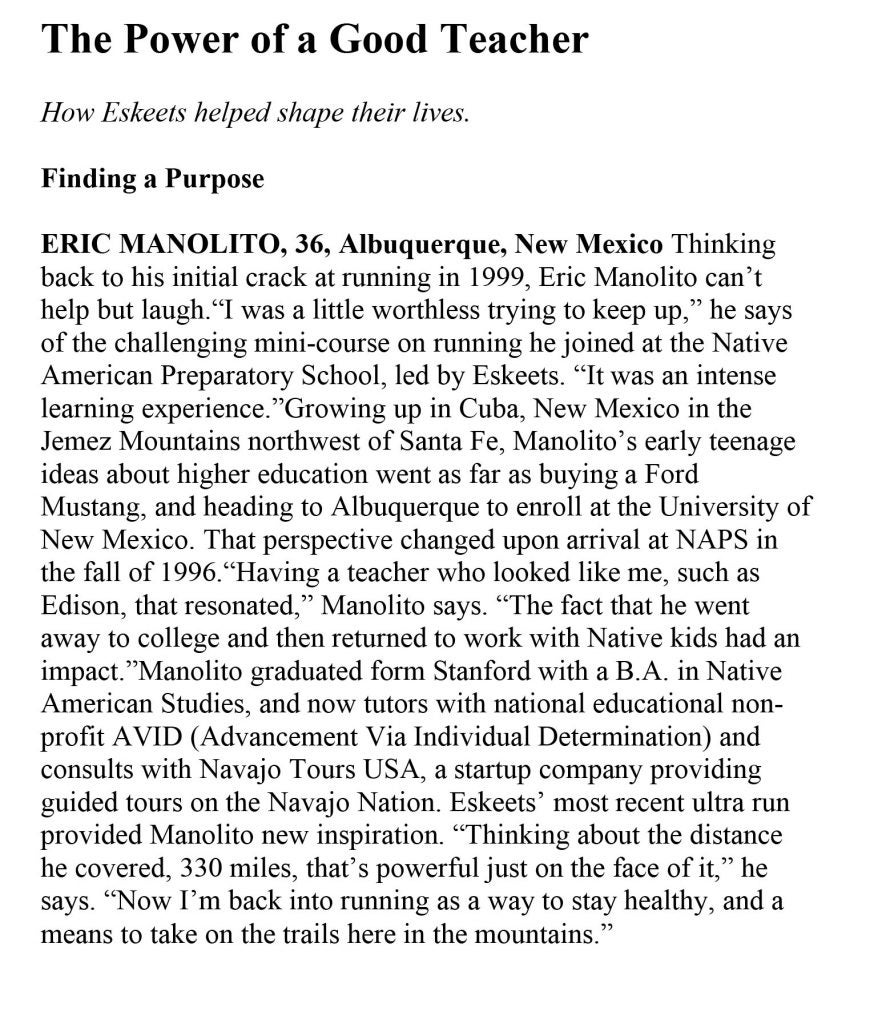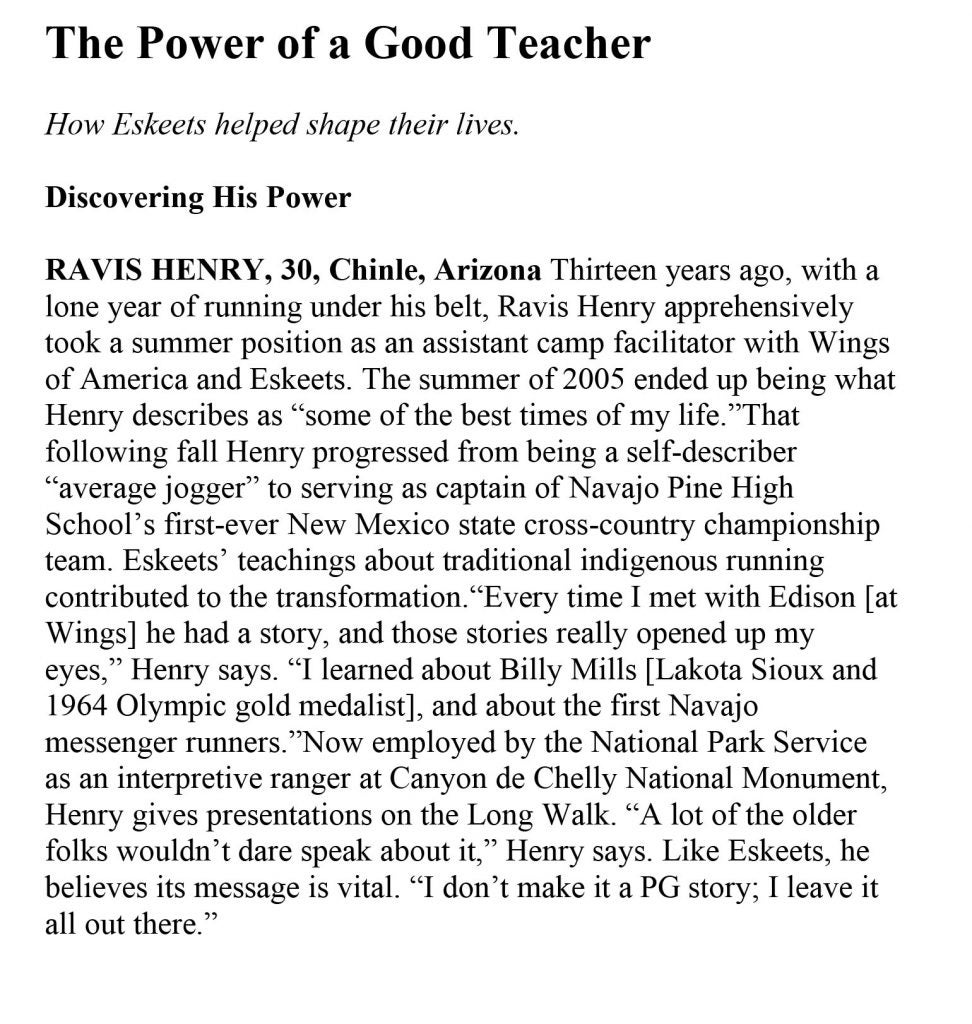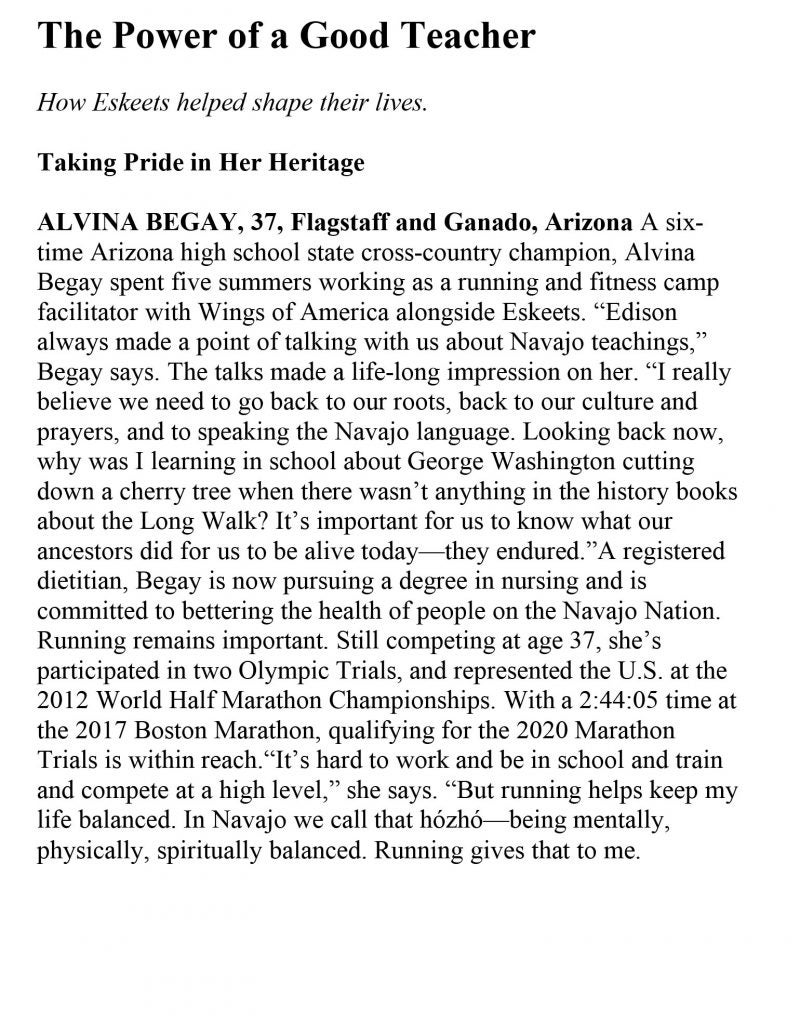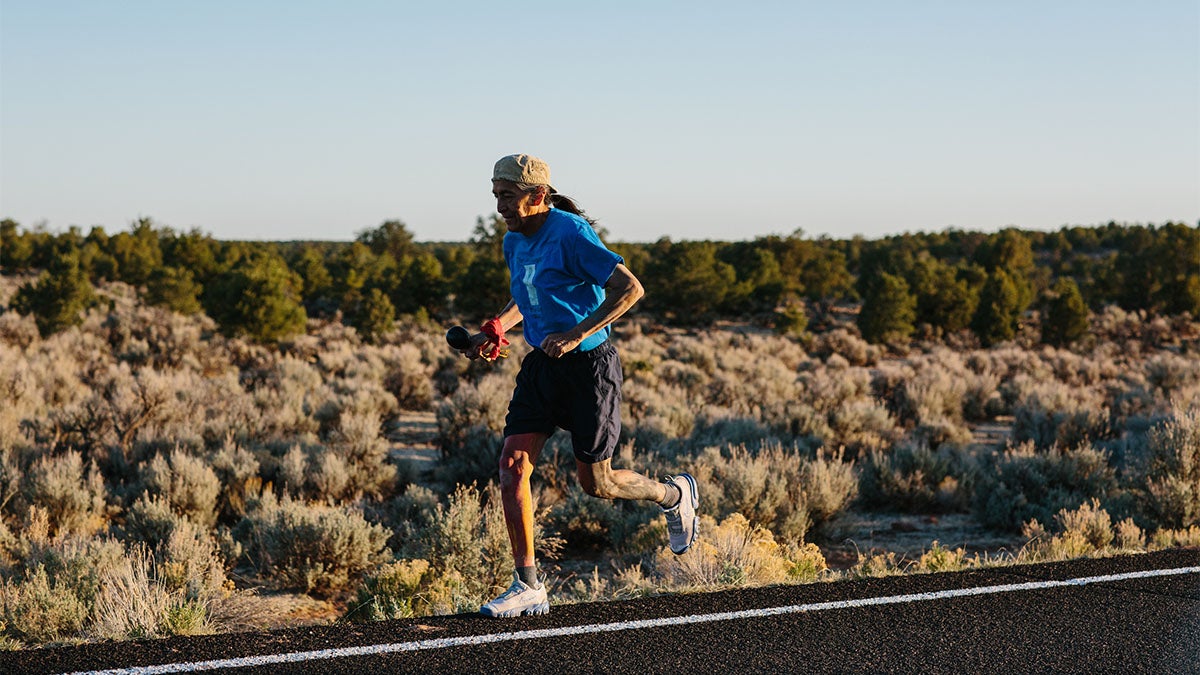Navajo ultra distance runner honors the Long Walk by retracing history step by step
Runner's WorldWhy this matters
By completing ultra-distance runs, Edison Eskeets honors his past and the Navajo's Long Walk and brings to action his teaching.
As predawn light colored the eastern Arizona sky, Edison Eskeets walked alone toward the south rim of Arizona’s Canyon de Chelly and gazed out at Spider Rock. He stood a slight 5'9" and 135 pounds, his long, brown hair streaked with gray. Bare-chested and wearing a kilt and moccasins, Eskeets, 12 days shy of his 59th birthday, briefly studied the 800-foot red sandstone monolith. He glanced across the layered canyon walls, toward the brightening pinkish-orange horizon, and in silent reverence, took in the ancient, sacred landscape, its meaning, and its significance.
Over a century and a half earlier, at Canyon de Chelly (pronounced də-SHAY) and the Southwest’s surrounding Four Corners region, more than 10,000 of Eskeets’s ancestors, Navajo men, women, and children, were subdued by the U.S. Army. A series of forced marches followed, with the Navajo traversing 350-plus miles on foot to a desolate landscape, now east-central New Mexico. Once there, the Diné, as the Navajo call themselves, were imprisoned. Hundreds perished during what became known as the Long Walk; several thousand would die in the brutal conditions experienced during a four-year internment.
Today, Eskeets planned to honor his people’s Long Walk with a run that roughly retraced their steps. (His adjusted route would accommodate modern roads, and allow his support van to ride along.) While many Navajo prefer to never speak of that era, Eskeets’s life’s work—a cross-country and track coach to Native students, teaching them Navajo art and history, and celebrating Diné culture—guided him otherwise. “The Navajo people suffered before, during, and after the Long Walk, but we survived,” he says. “We still have our language, our traditions, our creativity. My run is an acknowledgment of their survival, and the hope that this never happens again.”
Over his lifetime, Eskeets had completed four ultra-distance spiritual runs in recognition of Navajo culture, and on this chilly May morning, his final run would cover 330 miles in 15 days. “Of all the people I know, Edison has the best understanding of what matters and how we relate to one another,” says Matt Hannifin, a former science teacher who worked alongside Eskeets. “Part of his wisdom has to do with understanding how one’s path can change, even for people who have very little to start with.”
There’s Something Out There
Edison Eskeets was born in 1959 on his parents’ farm 20 miles northeast of Gallup, New Mexico, in the dispersed rural community of Springstead. His parents, Louis and Bessie Eskeets, had no formal education, and the family home lacked electricity and running water. Eskeets, the fifth of seven children, was kept out of school to help his mother tend the farm until age seven. “That meant I had a late start in English, because we only spoke Navajo at home,” he says. “I was always behind, even in college.”
From a young age Eskeets was constantly on the move, covering several miles a day tending the family’s sheep and goats at an altitude of nearly 6,500 feet. “When I was about five, I got this notion in me that ‘there’s something out there,’” Eskeets says. “That became a vehicle, a driving force—to see what’s out there. I still live by that.”
 Thanks to those farming miles and the altitude, at 15, Eskeets was sized up as a natural distance runner by the Gallup High School cross-country coach; he reluctantly agreed to run a three-mile time trial with the team. Eskeets blew the field away, finishing second. Suddenly, he was a varsity cross-country runner, his school days lengthened by practices and meets, hitchhiking home most evenings.
Thanks to those farming miles and the altitude, at 15, Eskeets was sized up as a natural distance runner by the Gallup High School cross-country coach; he reluctantly agreed to run a three-mile time trial with the team. Eskeets blew the field away, finishing second. Suddenly, he was a varsity cross-country runner, his school days lengthened by practices and meets, hitchhiking home most evenings.
After finishing 10th at the 1976 New Mexico state cross-country championships his junior year, Eskeets and his teammates were sidelined the following year when Gallup High’s coach left the school. Unable to compete, the promising runner went unnoticed by college programs, and Eskeets shelved the notion of higher education—until a call came from Jerry Tuckwin, cross-country and track coach at what was then Haskell Indian Junior College (now Haskell Indian Nations University) in Lawrence, Kan. Tuckwin offered Eskeets a spot on the team and the opportunity for a tuition-free education.
“At first my Mom said no, because I was supposed to be at home, helping take care of things,” Eskeets recalls. “Every few days I’d go back to her and say, ‘You know, this would be nice—I can try it.’ Lo and behold, in one of those conversations she said yes.”
[beauty_quote quote='On day seven, near Fort Wingate, New Mexico, on Interstate 40. By this point, Eskeets had run 120 miles.']
In August 1978, Tuckwin made his annual swing through northern Arizona and New Mexico, driving a small Haskell bus and collecting new student athletes from various tribal lands. “I picked up a few kids at Window Rock (Arizona, capital of the Navajo Nation),” Tuckwin says, “Edison was there with just his little bag and jean jacket, looking apprehensive.”
Saying goodbye to his mother, Eskeets promised her he’d return to live in the Southwest. It wouldn’t happen for more than a decade.
Exploring the Unknown
“I struggled at all levels,” says Eskeets of his adjustment to leaving home for the first time. But falling back on his natural talent, he found a way to endure and adjust. “What saved me was that running became an asset,” he explains. “It eased the pain, the pressure.”
 Within weeks of arriving at Haskell, several of Eskeets’s new teammates had quit and left for home; Tuckwin half-expected the shy recruit from Springstead to follow suit. “You could barely get Edison’s name out of him when he arrived, but his love of running was there, and he started blossoming,” Tuckwin says. “I was amazed at the transition that took place over two-and-a-half years. Now he’s such an articulate, unique person.”
Within weeks of arriving at Haskell, several of Eskeets’s new teammates had quit and left for home; Tuckwin half-expected the shy recruit from Springstead to follow suit. “You could barely get Edison’s name out of him when he arrived, but his love of running was there, and he started blossoming,” Tuckwin says. “I was amazed at the transition that took place over two-and-a-half years. Now he’s such an articulate, unique person.”
While visiting home prior to his final semester at Haskell in 1980, Eskeets told his parents he intended to undertake a five-day run. He’d planned a 135-mile route from Albuquerque to Gallup that would take him to Mount Taylor, the southernmost of the four peaks that demark the Navajo homeland and are sacred to the Diné. “That first run was an innate thing,” Eskeets says, “and I even told my parents I wasn’t sure why I had to do it. I had no clue until years later.” His father drove along with his younger sister Lorraine, and the three camped each evening.
Eskeets capped his Haskell career with a sixth-place, All-American finish at the 1980 national junior college cross-country championships at Coeur d’Alene, Idaho, and that strong showing helped secure a full-ride scholarship to Bradley University in Peoria, Illinois. An aspiring ceramicist, he jumped at the opportunity to pursue a degree in fine arts and take his running to the next level.
Although he reflects fondly on his time at Bradley, Eskeets’s running was hampered by intense training and unforgiving indoor track surfaces that brought on debilitating knee injuries. He withdrew from school after two semesters and didn’t run for a year, then resumed his studies in 1985 and made a major comeback to running. That October he logged a 2:26:18 at the Chicago Marathon, and it inspired him to work toward the 2:20 qualifying standard for the 1988 Olympic Trials. A year later, with his BFA degree from Bradley in hand, he took a job at a Bloomington, Ill., jewelry store and started upping his mileage.
On a windy Patriots’ Day in April 1987, Eskeets ran two-thirds of the Boston Marathon in a group that included four-time Boston champion Bill Rodgers, on pace to easily qualify for the Olympic Trials. But at mile 19, he suddenly felt an excruciating headache and fell off the lead pack. The buffeting winds slowed Rodgers to a 2:18:11 finish time, good for 15th, while Eskeets struggled to cross the line 80th in 2:31:21. Says Eskeets, “While it certainly wasn’t my fastest marathon, it felt like my bravest.”
Teaching, Coaching, Running Long
With his Olympic Trials aspirations unfulfilled, Eskeets decided it was time he returned to the Southwest. He spent a few years training docents at a museum in Flagstaff, then teaching art and coaching cross country and track at an elite college-preparatory high school in Mayer, Az. Though he loved it, in 1996 he was lured away to the Native American Preparatory School (NAPS) in Rowe, New Mexico.
Opened in 1995 as the nation’s only privately funded intertribal college prep school, NAPS quickly ranked among top private high schools based on student advancement to colleges and universities. While its enrollment was just over 100 students, the school represented nearly three dozen native tribes from more than a dozen states, including Hawaii.
 At NAPS, Eskeets taught and coached again, and he soon took on administrator roles. The school flourished, attaining a graduation rate of 99 percent that brought NAPS national acclaim. Eskeets was eventually promoted to a headmaster role, where he became intertwined with NAPS’s financial challenges: 98 percent of students depended on need-based financial aid, and money was always short.
At NAPS, Eskeets taught and coached again, and he soon took on administrator roles. The school flourished, attaining a graduation rate of 99 percent that brought NAPS national acclaim. Eskeets was eventually promoted to a headmaster role, where he became intertwined with NAPS’s financial challenges: 98 percent of students depended on need-based financial aid, and money was always short.
Compelled to raise funds for the school, and to continue the spiritual journey through Navajo Nation that he started back in his Haskell days, Edison came up with a solution: an ultrarun.
During his first attempt that June, Eskeets took only six days to cover 208 miles from Flagstaff to Gallup, including an ascent of 12,633-foot Humphrey’s Peak, one of the San Francisco Peaks sacred to the Navajo. Less than two years later, he tackled his most ambitious ultra, a 10-day, 375-mile trek that included runs up sacred mountains Blanca and Hesperus in southern Colorado. Between the two ultras, Eskeets raised almost $90,000 for NAPS scholarships. What’s more, the long runs delivered a crucial perspective.
“Gradually, as I thought about the sacred mountains that Navajos pray to every single day, I saw that my runs were about honoring those sites from the past to the present and into the future,” Eskeets says. “And in that way, the runs were really about the Navajo people and their voices and prayers and thoughts—and acknowledging that we’re still here.”
In early 2001, Eskeets left the academic setting of NAPS to become executive director of Wings of America, a nonprofit in Santa Fe. Established in 1988, Wings uses running as a catalyst to empower Native American youth to take pride in their cultural traditions, embrace educational opportunities and healthful living, and make responsible decisions. Each summer Wings holds up to two dozen running and fitness camps in tribal communities across the Southwest, and every winter coaches assemble teams of elite indigenous athletes to compete at the USA national cross-country championships. In the past 30 years, Wings athletes have won more than 20 national junior titles.
As executive director at Wings, Eskeets traveled throughout the country, generating funds and support for the program. “He’s charismatic and people gravitate toward him—he’s able to communicate with the students, and get Native kids out of their comfort zones,” says James Nells, a Navajo who ran with Eskeets at Haskell, and who also coached the Wings elite teams in 2001, 2003, and 2014.
After six years at Wings, a new opportunity arose at Hubbell Trading Post National Historic Site. Opened in 1878 in Ganado, Az., Hubbell still functions as a place where Navajo, Hopi, and other Native Americans trade and sell handcrafted woven goods, baskets, jewelry, and pottery. As the first Navajo trader employed at Hubbell, Eskeets helps curate Navajo goods, and passes along his insights on Navajo rug design to visitors—as well as his philosophy that people are more alike than different. Every one of his popular rug talks ends with the same line: “If your blood is red, you’re my kind.”
“The Message—The Run”
Not long after beginning work at Hubbell in 2007, Eskeets came up with the idea of a final ultra-distance run. He wanted to try a route that would trace much of the Long Walk, and also honor the history of Native long-distance messengers: For centuries, fleet-footed, supremely fit young Navajo would literally run messages from tribe to tribe, and were essential to survival during war.
But committing to this ultra took nearly a decade. “The biggest challenge was the spiritual aspect,” he explained. “There’s an element that’s so powerful, because of all that transpired during the Long Walk and after, with the treaty of 1868 and the government saying, ‘When you sign here, you’re going to leave your language, your law system, your farming, and your children will attend our schools.’ It’s hard to look back at it, and there’s still a lot of bitterness among the Navajo people.”
[beauty_quote quote='"There’s an element that’s so powerful, because of all that transpired during the Long Walk and after, with the treaty of 1868 and the government saying, ‘When you sign here, you’re going to leave your language, your law system, your farming, and your children will attend our schools.’ It’s hard to look back at it, and there’s still a lot of bitterness among the Navajo people.” - Edison Eskeets']
Ultimately it was a deep wish to honor his ancestors that convinced Eskeets to go forward with his idea: a 330-mile, 15-day run beginning May 18, 2018, from Canyon de Chelly to the historic Plaza in Santa Fe, site of New Mexico’s territorial capitol. The run’s end on June 1 would coincide with the 150th anniversary of the Navajo Treaty, which allowed the Diné to return to their homelands. Eskeets dubbed the undertaking “The Message—The Run,” to acknowledge Navajo suffering during the Long Walk era, and celebrate their ultimate survival.
Eskeets decided to donate the money he would raise (ultimately, it would be $90,000) to the Western National Parks Association and educational programming at Hubbell. Then he called his sister Lorraine: “When he told me he was going to do another run, his final run, I said, ‘Well, you know what, Ed? If this is going to be your last one, I started it with you, let’s end it together.’” Lorraine’s husband, Jason Bunion, agreed to drive, and the couple’s daughter, Jay-lynn, convinced her parents to let her miss two weeks of her sophomore year of high school. The support team was in place; the run was on.
Just before dawn on May 18, a small group gathered above Spider Rock, sacred to the Navajo as the home of Spider Woman, who taught the Diné the art of weaving. Eskeets began with a ceremony honoring that tradition, which included a rug that master weaver Mary Henderson Begay had woven especially for use that morning.

Eskeets kneeled on the rug, looked out toward the canyon, and spoke Navajo words of recognition for the Diné’s survival. “I made the connection between the elements—the earth, the wind, the water, the fire,” he recalls. “And I gave thanks that there’s life here, it’s still evolving as we go along.” To end the ceremony, Eskeets sprinkled white cornmeal on each of those in attendance. “It was a token to the words, the surroundings, and the event, giving acknowledgment,” he says.
At 6:10 a.m., dressed in the attire of a traditional Navajo long-distance messenger and carrying an Apache-made rattle, Eskeets set off into the 39-degree morning. The rattle was a gesture to the Apache people, at least 500 of whom had also been interned along with the Navajo.
Eskeets broke most days into three running segments, totaling some 20 to 25 miles. His shortest running day was his third, 11 miles, and it ended at Hubbell Trading Post. His 95-year-old mother, Bessie, was there, as were his siblings Emerson, Lorraine, and Irene.
“This run has been in the works for over 10 years,” Eskeets said to the crowd assembled at Hubbell. “The preparation has been going on over 40 years—I’ve run over a quarter million miles [in that time]. The Long Walk is a part of this. People were hurt, they starved, there was homesickness and sickness. I’m feeling every inch of it. You know how people talk about having a purpose? This is down to the core. And it has nothing to do with running, nothing to do with athleticism. This is about humanity.”
[beauty_quote quote='"You know how people talk about having a purpose? This is down to the core. And it has nothing to do with running, nothing to do with athleticism. This is about humanity.” - Edison Eskeets']
And partly, about its future. “That Edison put himself on display, showing people how physically and emotionally taxing a journey like that is, is very important,” says Wings executive director, Dustin Martin. “I try to remind kids that running and moving over the land, and knowing the land on our own two feet, is in our blood. Young Native people need to have some vision of that, because it’s our heritage.”
After averaging 22 miles per day for two weeks, Eskeets’s final, 26-mile day was his longest. He battled high winds, temperatures in the 90s, tendinitis in both ankles, and heavy interstate traffic along the approach to Santa Fe. Awaiting his arrival was 76-year-old former Haskell coach and athletic director Jerry Tuckwin, who had given little regard to a heart ailment to travel from Kansas to be on hand. “My wife and I went out from the finish a half a mile or so,” he says, “and when we saw him coming up the last long hill, he was just flying—I swear, he looked like he was racing a 5K.” Edison ran those last 10 miles in just over an hour.
Not that Tuckwin couldn’t believe it: “I’ve learned, when Edison sets his mind to something, somehow, he does it,” he says. “He told me afterwards, ‘It wasn’t a run—it was a beautiful dance for 330 miles; I danced the whole way for our people.’”
Courtesy Runner's World Magazine


